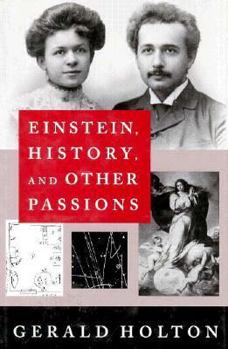Einstein, History, and Other Passions
Select Format
Select Condition 
Book Overview
"[The] book makes a wonderfully cohesive whole. It is rich in ideas, elegantly expressed. I highly recommend it to any serious student of science and culture."--Lucy Horwitz, Boston Book Review "An... This description may be from another edition of this product.
Format:Hardcover
Language:English
ISBN:1563963337
ISBN13:9781563963339
Release Date:January 1995
Publisher:American Institute of Physics
Length:312 Pages
Weight:1.20 lbs.
Dimensions:0.9" x 6.6" x 9.6"
Customer Reviews
1 rating
Science from many perspectives
Published by Thriftbooks.com User , 21 years ago
There are many attributes associated with scientists, from the solitary genius (rarely true), to the mad (almost exclusively myth), to the dispassionate observer of nature (only partially true). Each of these attributes is addressed in this book, along with some of basic philosophical principles of science. Holton begins the book by describing the only scientist everyone knows, Albert Einstein. The equivalent of a rock star in the early part of the twentieth century, he had a level of celebrity that no scientist has had since. It is likely that only Archimedes and Newton matched the level of awe the public applied to him. However, much of the emphasis is on Einstein's love affair with Mileva Maric, where he is displayed as a man of considerable passion, and not just for physics. Einstein comes across as a young man of great confidence, yet having a need for companionship and close personal relationships. Some of the correspondence between Einstein and Mileva is published, and the point is to show that even Einstein was not a solitary genius, although he is often portrayed as such. The second segment of the book is a series of essays concerning the role of science and the scientist in culture. Even the most scientifically illiterate person is well aware of the significant role that science and the technological offshoots have on civilization. Nevertheless, scientists cannot observe without altering, interpreting and expressing their human roots, so some of the points deal with the fundamentals of what scientists are. Some of the points are quite radical, such as questions concerning the credibility of scientific research and whether there are indeed any truths to be found. Segment three is a series of short biographies of some of the greatest characters in science in the twentieth century: J. Robert Oppenheimer, Percy W. Bridgman, I. I. Rabi, Richard Feynmann and Michael Polanyi. Certainly the greatest character of them all was Feynmann, whose most amazing characteristic was his insatiable curiosity and willingness to try almost anything. As you read about his many interests, you wonder how he ever found time to do Nobel Prize caliber physics. The closing segment contains two essays, the first on whether the history of science has a place in the teaching of science and the conclusion is a heavily qualified yes. The role of equipment and in-class experiments is covered in the second. Lectures are valuable, but there is nothing like a demonstration of a physical principle to get the point across. While I remember nothing that was said in my high school classes, I do remember some of the classroom demonstrations, such as static electricity. Science is performed by humans, so like everything else, it has a culture, has results that can be suspect and alters all that comes in contact with it. Since science comes in contact with everything, even in the most insular of societies, how science and society react to each other is a significant component






